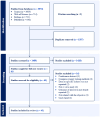A systematic review and individual bacterial species level meta-analysis of in vitro studies on the efficacy of ceftazidime/avibactam combined with other antimicrobials against carbapenem-resistant Gram-negative bacteria
- PMID: 39691958
- PMCID: PMC11787894
- DOI: 10.1093/jac/dkae451
A systematic review and individual bacterial species level meta-analysis of in vitro studies on the efficacy of ceftazidime/avibactam combined with other antimicrobials against carbapenem-resistant Gram-negative bacteria
Abstract
Background: Carbapenem-resistant Gram-negative bacteria (CR-GNB) develop resistance to many antimicrobials. To effectively manage infections caused by these organisms, novel agents and/or combinations of antimicrobials are required.
Objectives: Evaluated the in vitro efficacy of ceftazidime/avibactam in combination with other antimicrobials against CR-GNB.
Methods: PubMed, Web of Science, Embase and Scopus were searched. Study outcomes were quantified by counting the number of isolates exhibiting synergy, defined as a fractional inhibitory concentration index ≤ 0.5 for checkerboard and Etest, and a >2 log cfu/mL reduction for time-kill studies. The proportion of synergy was calculated as the ratio of isolates exhibiting synergy to the total number of isolates tested. These proportions were analysed using a random-effects model, following the Freeman-Tukey double-arcsine transformation.
Results: Forty-five in vitro studies were included. A total of 734 isolates were tested, and 69.3% of them were resistant to ceftazidime/avibactam. The combination of ceftazidime/avibactam with aztreonam showed a high synergy rate against carbapenem-resistant Klebsiella pneumoniae (effect size, ES = 0.91-0.98) and Escherichia coli (ES = 0.75-1.00). Ceftazidime/avibactam also demonstrated a high synergy rate (ES = 1) in time-kill studies when combined with azithromycin, fosfomycin and gentamicin against K. pneumoniae. Compared to ceftazidime/avibactam alone, a higher bactericidal rate was reported when ceftazidime/avibactam was combined with other antimicrobials against carbapenem-resistant K. pneumoniae (57% versus 31%) and E. coli (93% versus 0%).
Conclusions: Ceftazidime/avibactam frequently demonstrates synergistic bactericidal activity when combined with various antimicrobials against CR-GNB in in vitro tests. Further pre-clinical and clinical studies are warranted to validate the utility of ceftazidime/avibactam-based combination regimens for CR-GNB infections.
© The Author(s) 2024. Published by Oxford University Press on behalf of British Society for Antimicrobial Chemotherapy.
Figures
References
-
- World Health Organization . WHO Bacterial Priority Pathogens List: Bacterial Pathogens of Public Health Importance to Guide Research, Development and Strategies to Prevent and Control Antimicrobial Resistance. WHO, 2024.
-
- Hamzaoui Z, Ocampo-Sosa A, Fernandez Martinez M et al. Role of association of OmpK35 and OmpK36 alteration and blaESBL and/or blaAmpC genes in conferring carbapenem resistance among non-carbapenemase-producing Klebsiella pneumoniae. Int J Antimicrob Agents 2018; 52: 898–905. 10.1016/j.ijantimicag.2018.03.020 - DOI - PubMed
Publication types
MeSH terms
Substances
LinkOut - more resources
Full Text Sources
Medical




